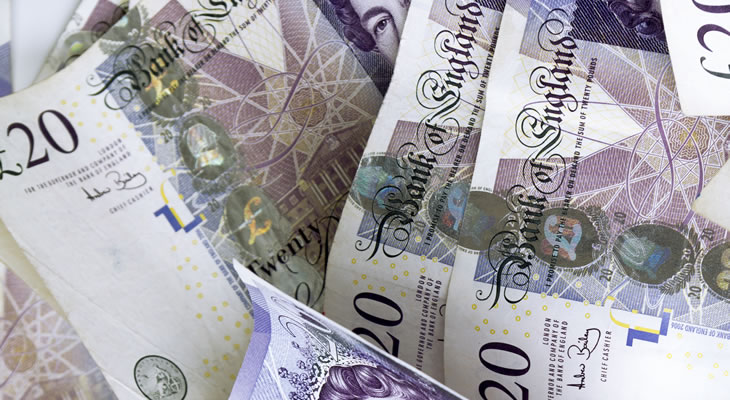- Pound CAD Exchange Rate Briefly Hits 1.73 – Wednesday rally takes pair above key level
- Sterling Plunges after Poor UK Retail Sales – Brexit jitters and poor weather blamed
- Canadian Dollar Mixed as Oil Prices Rise – Low risk-sentiment weighs on ‘Loonie’ favour
- Forecast: Preliminary July UK PMI Due on Friday – As well as Canadian inflation figures
The Pound CAD exchange rate gained over two cents throughout Wednesday’s session, as low risk sentiment and solid UK economic news allowed the pair to easily capitalise. However, the pair sank lower on Thursday on profit-taking and disappointing UK retail sales data.
GBP/CAD briefly touched on a high of 1.7327 on Wednesday night, its best reading since last week and within the region of July’s highest levels. While GBP/CAD initially plummeted to a low of 1.7312 after the release of Britain’s June retail sales data, the pair began to trend in the region of 1.7212 once investors realised that the data was more influenced by the weather than the Brexit.
Sterling (GBP) Fluctuates Widely on Mixed June UK Data
The Pound has been up and down all this week, making larger and larger fluctuations as the week goes on and investors react in droves to the week’s data and forecasts.
The last weeks of July means that we’ll be starting to see more and more data collected over the course of June.
Many will remember June as being the run up to the EU Referendum, when bets and polls indicated a different result every other day and markets panicked about the possibility of a Brexit. As a result, data collected throughout June was expected to reflect this uncertainty and panic.
This is part of why Wednesday’s May unemployment figures and June jobless claims numbers impressed investors. With unemployment falling as low as 4.9%, investors maintained hope that the UK job market would be solid enough to soften the blow of Brexit damage in June and July.
Sterling slumped again on Thursday, falling away from its best July levels once more as investors reacted to June’s poor UK retail sales figures. While the data was largely collected before the Referendum, sales experienced their biggest drop since November.
The Pound initially plummeted, but settled a little higher once investors realised that the poor figures were due to June’s weather rather than Brexit damage. Reuters reported;
‘British retail sales suffered their sharpest monthly fall in six months in June, with officials citing poor weather hurting clothing sales rather than any impact from the vote to leave the European Union.
Retailers had not reported any anecdotal evidence of the unexpected result of the June 23 referendum affecting sales during the five-week period which ended July 5, the Office for National Statistics said.’
Canadian Dollar (CAD) Strength Seeps Back after Bearish Run
The Canadian Dollar has struggled to remain appealing to investors in recent weeks as low prices of oil (Canada’s most lucrative commodity) and other domestic economic concerns have weighed the currency down.
The currency got a mild boost last week when the Bank of Canada (BOC) took a relatively hawkish tone in its July policy meeting. However, oil prices have slipped and struggled around the level of US$45 since shortly after the Brexit result in late-June.
However, according to Bloomberg, oil prices finally saw a little relief over Tuesday and Wednesday’s American sessions;
‘Oil rose for a second day in New York, extending its gain from a two-month low, after U.S. crude stockpiles declined for a record ninth week and refining activity climbed to a 2016 high.’
News that the Canadian Dollar had finally hit levels higher than it was trading at a year ago may also have slightly bolstered ‘Loonie’ sentiment.
Pound CAD Exchange Rate Forecast: Will the Canadian Dollar Strengthen?
Friday is set to be an influential day for UK and Canadian data. For Britain, markets will finally see July’s preliminary PMI reports.
This means that markets will be given a more solid indication of how the Brexit result has effected the UK economy since the result in late-June. While Services is the UK’s biggest sector, the Manufacturing SA PMI is also likely to be vital.
Services are expected to fall from 52.3 to 48.7 and Manufacturing from 52.1 to 47.5. A bigger drop than this would likely indicate that the Brexit has effected these sectors more than forecasters predicted, which would send the Pound plummeting.
As for Canada, the nation’s May retail sales report as well as June Consumer Price Index (CPI) will be released in the afternoon. All figures are expected to indicate slowing, so markets will hope for better-than-expected scores as an excuse to pour into the ‘Loonie’.
Analysts have recently suggested that the ‘Loonie’ is becoming something of a ‘safe-haven’ amid recent political and economic turmoil, as the Canadian economy seems largely unaffected by recent news. According to the Huffington Post;
‘Some investors are flocking to the Canadian Dollar in search of a “safe haven” currency amid global political and economic turmoil …
Still, many analysts don’t see a real rebound for the ‘Loonie’ until oil prices start rising again. While calls for a 59-cent dollar have cooled off with the ‘Loonie’s recent strength, many analysts say the ‘Loonie’s growth is limited so long as oil prices are low.’
At the time of writing, the Pound CAD exchange rate trended in the region of 1.7225, while the CAD Pound exchange rate traded at levels around 0.5800.


Comments are closed.